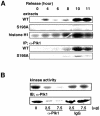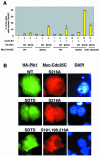Plk1 promotes nuclear translocation of human Cdc25C during prophase
- PMID: 11897663
- PMCID: PMC1084057
- DOI: 10.1093/embo-reports/kvf069
Plk1 promotes nuclear translocation of human Cdc25C during prophase
Abstract
The nuclear accumulation of active M-phase promoting factor (MPF) during prophase is thought to be essential for coordinating M-phase events in vertebrate cells. The protein phosphatase Cdc25C, an activator of MPF, enters the nucleus to keep MPF active in the nucleus during prophase. However, the molecular mechanisms that control nuclear translocation of Cdc25C during prophase are unknown. We show that phosphorylation of a serine residue (Ser198) in a nuclear export signal sequence of human Cdc25C occurs during prophase and promotes nuclear localization of Cdc25C. We also show that Polo-like kinase 1 (Plk1) is responsible for this phosphorylation and that constitutively active Plk1 promotes nuclear localization of Cdc25C. Remarkably, a mutant Cdc25C in which Ser198 is replaced by alanine remains in the cytoplasm when wild-type Cdc25C accumulates in the nucleus during prophase. These results suggest that Plk1 phosphorylates Cdc25C on Ser198 and regulates nuclear translocation of Cdc25C during prophase.
Figures






Similar articles
-
Polo-like kinase 1 phosphorylates cyclin B1 and targets it to the nucleus during prophase.Nature. 2001 Mar 8;410(6825):215-20. doi: 10.1038/35065617. Nature. 2001. PMID: 11242082
-
Cdc25C phosphorylation on serine 191 by Plk3 promotes its nuclear translocation.Oncogene. 2004 Apr 8;23(15):2658-63. doi: 10.1038/sj.onc.1207425. Oncogene. 2004. PMID: 14968113
-
Active cyclin B1-Cdk1 first appears on centrosomes in prophase.Nat Cell Biol. 2003 Feb;5(2):143-8. doi: 10.1038/ncb918. Nat Cell Biol. 2003. PMID: 12524548
-
Control of mitosis by changes in the subcellular location of cyclin-B1-Cdk1 and Cdc25C.Curr Opin Cell Biol. 2000 Dec;12(6):658-65. doi: 10.1016/s0955-0674(00)00149-6. Curr Opin Cell Biol. 2000. PMID: 11063929 Review.
-
Many fingers on the mitotic trigger: post-translational regulation of the Cdc25C phosphatase.Cell Cycle. 2004 Jan;3(1):41-5. Cell Cycle. 2004. PMID: 14657664 Review.
Cited by
-
The Catalytic Subunit of DNA-Dependent Protein Kinase Coordinates with Polo-Like Kinase 1 to Facilitate Mitotic Entry.Neoplasia. 2015 Apr;17(4):329-38. doi: 10.1016/j.neo.2015.02.004. Neoplasia. 2015. PMID: 25925375 Free PMC article.
-
Polo-like kinase 1 is overexpressed in colorectal cancer and participates in the migration and invasion of colorectal cancer cells.Med Sci Monit. 2012 Jun;18(6):BR237-46. doi: 10.12659/msm.882900. Med Sci Monit. 2012. PMID: 22648245 Free PMC article.
-
Polo-like kinases mediate cell survival in mitochondrial dysfunction.Proc Natl Acad Sci U S A. 2009 Aug 25;106(34):14542-6. doi: 10.1073/pnas.0904229106. Epub 2009 Aug 11. Proc Natl Acad Sci U S A. 2009. PMID: 19706541 Free PMC article.
-
The Polo-like kinase Plx1 interacts with and inhibits Myt1 after fertilization of Xenopus eggs.EMBO J. 2005 Mar 9;24(5):1057-67. doi: 10.1038/sj.emboj.7600567. Epub 2005 Feb 3. EMBO J. 2005. PMID: 15692562 Free PMC article.
-
BI6727, a polo-like kinase 1 inhibitor with promising efficacy on Burkitt lymphoma cells.J Int Med Res. 2020 May;48(5):300060520926093. doi: 10.1177/0300060520926093. J Int Med Res. 2020. PMID: 32468878 Free PMC article.
References
-
- Blasina A., Van de Weyer, M., Laus, M.C., Luyten, W.H., Parker, A.E. and McGowan, C.H. (1999) A human homologue of the checkpoint kinase Cds1 directly inhibits Cdc25 phosphatase. Curr. Biol., 9, 1–10. - PubMed
-
- Coleman T.R. and Dunphy, W.G. (1994) Cdc2 regulatory factors. Curr. Opin. Cell Biol., 6, 877–882. - PubMed
-
- Furnari B., Rhind, N. and Russell, P. (1997) Cdc25 mitotic inducer targeted by chk1 DNA damage checkpoint kinase. Science, 277, 1450–1451. - PubMed
Publication types
MeSH terms
Substances
LinkOut - more resources
Full Text Sources
Other Literature Sources
Molecular Biology Databases
Research Materials
Miscellaneous

